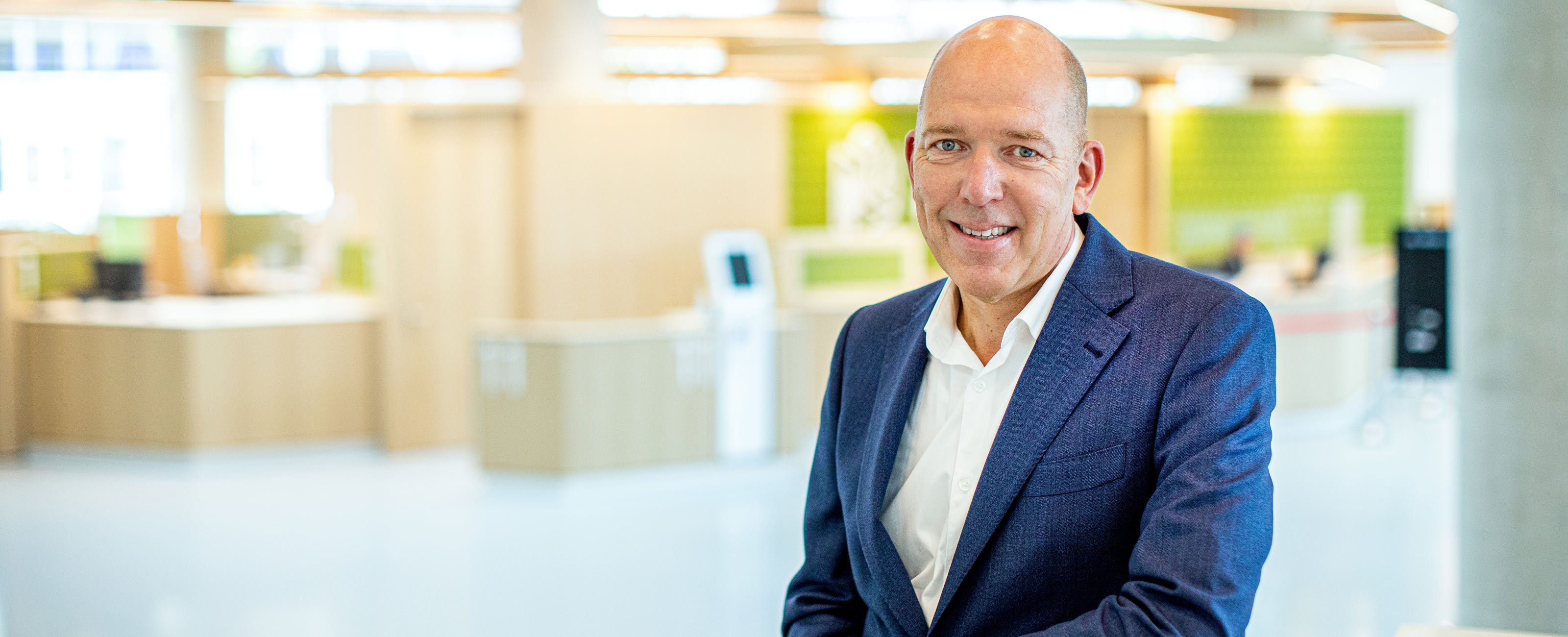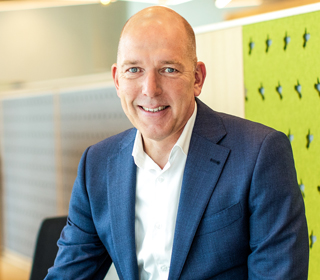Martin Fleer, client on behalf of city of Hengelo
‘The design of the new town hall is the result of a genuine partnership’
In early 2020 the moment had arrived. The new town hall in Hengelo finally opened their doors. It was the culmination of a very successful collaboration, says Martin Fleer, who acted as client on behalf of the city of Hengelo.
“The municipal offices form part of a very large area development comprising housing, shops and cafés in the centre of Hengelo,” explains Fleer. “That development suffered serious delays owing to the economic crisis that started in 2008. In 2016 the city council separated the new offices from the larger development, and that was the moment we could start building.”
When presenting their vision, EGM architects stated: ‘We’re going to make this a Hengelo building.’ We knew then that we were on the right track
Partners from the start
All that time the EGM design was just lying on the shelf, waiting for the go-ahead. Fleer: “The design was completed shortly after the council decision in 2009. But the economic crisis meant that it was far from certain whether the building would ever see the light of day. The wait lasted for a number of years, and throughout that period we had a lot of contact with Victor de Leeuw, the supervisor responsible at EGM. Any time Hengelo city council discussed a matter relating to the planned building, he was there. We were real partners right from the start.”
Respect for monumental town hall
That start was a striking presentation of the design vision by EGM, recalls Fleer. “For the city council, the relationship with the existing monumental town hall was very important in the choice of architect. The imposing and dominant design by architect Berghoef is one of the city’s icons. I can still hear Victor saying it with a sense of awe: ‘I’m not going to compete with a national monument.’ In his presentation he promised us a ‘Hengelo’ building that would enhance the existing city hall. And he would avoid the type of conspicuous structure favoured by some architects, no matter where. That gave us confidence.”
Beauty versus function
In the design process there is always a classical tension between beauty and functionality. Fleer: “We had plenty of discussions of this kind, but we always managed to resolve them. It was very much a case of co-makership. That also manifested itself in the choice of materials. The centre of Hengelo consists entirely of post-war reconstruction architecture, with plenty of stone. That stone is echoed in the design, with here and there a nod to Twente cultural heritage. You see that the new and old building are part of the same family. A real connection with the city has been created. Moreover, you now enter the municipal offices at a spot that used to be a window. The architects simply punched an opening in the facade to turn two buildings into one complex.”
Involving the users
EGM was also responsible for the interior design. Fleer: “Interior architect Jeroen de Bruin worked with two groups of users during the design phase. One group focused on functionality, the other on beauty. Together they embarked on a very productive collaboration. Jeroen took the groups around the city centre and outlying areas to find out what is really distinctive about Hengelo. Those were very constructive and enjoyable sessions that boosted the design.” Moreover, the interior design responds to the wish of the municipality to stimulate encounters between the various domains. And what the users definitely did not want was an open office landscape. “So we didn’t give them one,” stresses Fleer. “The interior is open and transparent, encouraging social interaction among users. There are no fixed floors for the various domains, and there are only flexible workstations. There is also ample opportunity for informal and alternative consultations in domestic settings.”
The architects simply punched an opening in the facade to turn two buildings into one complex
No disposable furniture
The new municipal offices meet all innovative requirements concerning sustainability you should expect from a contemporary building. That was an important criterion in selecting the architect, according to Fleer. “At the explicit request of municipal employees, the choice of new furniture is based on reuse. As a municipality, we want to take a stand against the ‘throwaway society’. With Gispen as partner, we now have sofas with seats made of old matrasses and coat hangers made of old desktops.”
Selecting the sustainable solution
Throughout the design – both architecture and interior – circularity and sustainability were key factors. Fleer: “In selecting materials for fixed interior elements, Jeroen always opted for the most sustainable solution. For example the fixed reception desks, walls and cabinets are made of fast-growing Dutch poplar wood. In addition, the timber joints are not glued but held together with elegant brass screws. All acoustic panels are covered in felt made from PET bottles. And stylized images of Hengelo districts have been punched into the felt. Both the exterior and the interior are the result of a genuine partnership.”
Maud van Gennip, writer and copywriter, interviewed Martin Fleer in juni 2020
Project: Hengelo city hall

